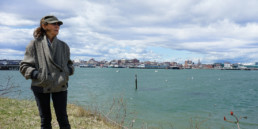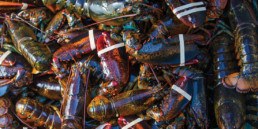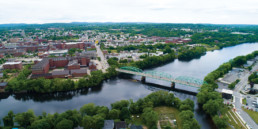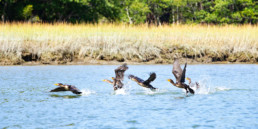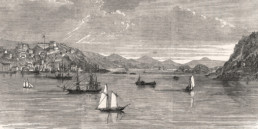Taking Stock of a Downeast River
History, heritage, and commercial viability of the last smelt run hang in the balance.
BY JON KELLER
Five degrees above zero and the wind peels northwest. Sky and river both black dark. Headlights shine in the small parking lot. The wind howls, rocks the truck. Out there in the headlight shine lies a slick mud bank and a river of churning brown water.
Bobby Beal’s at the wheel. He’s a local clam digger and lobster fisherman and tuna fisherman; a hunter and trapper and taxidermist and registered Maine guide.
If there’s an animal that needs to be tracked, caught, trained, tamed, saved, or killed, Bobby is the man to do it.
With him is Dwayne Shaw, the executive director of the Downeast Salmon Federation (DSF), a grassroots conservation group that he’s headed since its inception in the early 1980s. A mix of mountain man, fisherman, redneck, hippie, and environmentalist, Dwayne may very well know more about the waterways that lace the coast of Maine between Bar Harbor and Canada than anyone.
“Cold out there,” Bobby says.
The heater’s on full blast and inside the truck has to be over 90 degrees.
Dwayne laughs. “But it’s a good smelt tide,” he says.
I lean back in the truck seat, watch the water roll by, the streaks of wind flipping wrinkles of wave and skating piles of dark foam across the water and mud, both. The arm of the river in front of us—the West Branch of the Pleasant River—is dammed by a clapper that allows water to exit but not enter, thus destroying what was once a tidal estuary teeming with life. Not good, Dwayne says, for smelt, and he and the Downeast Salmon Federation have been lobbying for years to remove the clappers, but thus far to no avail.
The main branch of the Pleasant lies to the east, an exposed corridor sided by long stretches of treeless marshlands that flood with the full and new moon tides.
It’s dark now, and we can see little of the river, only feel the wind that howls over the icy marshlands, the water riotous, the waves bristling and breaking.
We untie the boat and flip it to the ground before the wind can take it. Bobby and I drag it over the riprap and down the smooth, hard mud. It’s half tide, and the seawater presses upward against the river fall.
We load anchors and gillnets into the canoe. Dwayne hands a spotlight to Bobby and says, “Don’t forget to rescue us if we flip.”
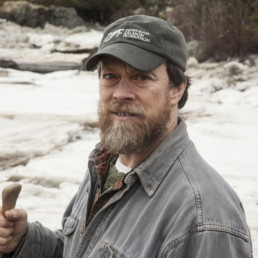
Dwayne Shaw
Photo: Leslie Bowman
“I’ll just get in the truck and put the gas to the floor. She’ll make it far enough for you to touch your toes on the roof, anyway.” He laughs, just a little. “That way we’d all be drowned.”
It’s a joke, but not a joke. In two separate incidences, decades apart, Bobby lost four uncles, his father, and his grandfather to the neighboring Harrington River—the river he and his brother and sons and daughter and son-in-law and grandsons all make a living on as clam diggers and lobster fishermen, the river his mother’s house looks out upon; all of the drowned men had been on their way home from digging their day’s clam tides when their skiffs overturned in the cold, fast water.
Dwayne and I push off. The idea is to set all three nets in the 100-yard stretch of the West Branch that runs from the clapper dam to the confluence with the main stem of the Pleasant River. Dwayne sits in the bow and works the nets, tells me where to go. Bobby stays on shore, working the spotlight. The mud banks are dotted by the remnants of wharves and pilings, evidence of the shipbuilding that dominated the river in centuries past, back when this was a town bustling with people and commerce.
A streetlight glows on the few homes that make up the current village of Addison, just across the West Branch from the parking lot. At the light’s edge, the derelict shape of what was once the town’s clam shucking house looms atop the mud bank, sided by ages of clamshell midden.
We nose against the tide. Dwayne drops an anchor and begins working the net out as we back. When the net goes tight, he drops the second anchor and buoy. We do this two more times, laying out all three gillnets with the current, an anchor and buoy marking each end of each net so that if you were to see them from above it would look like the raking of a three-toed claw.
Several miles up the main branch of the Pleasant River stands the town of Columbia Falls, and the head-of-tide pool into which the namesake waterfall tumbles. The pool is circular, roughly a half-mile across; the wedding place of fresh and salt water. Above the pool and falls, the Pleasant River runs fresh and brown with tannins, an artery pumping out of a sprawling heath watershed of oak and red maple; below lies salt marsh and tidal waters and ocean.
There was once a small hydroelectric dam blocking the waterfall, but the dam is gone and all that remains are remnant fractions of concrete, the failed fish ladder, and the building that now houses a portion of the Downeast Salmon Federation’s facilities, including its former salmon hatchery. A state of the art facility in nearby East Machias holds the DSF’s new, high-tech hatchery, together with a host of additional offices.
Since the DSF began in 1982, it’s grown from three dedicated people trying to lend voice to Downeast Maine’s struggling Atlantic salmon population into a thriving network of a dozen full-time employees and a host of volunteers and communities fighting for rivers and salmon and public lands; and the DSF’s fight has gone well, with nearly 3,000 acres of waterfront land and 23 miles of streams and rivers conserved—not bad for a small town, grassroots group operating in one of the poorest counties in the nation.
The truck idles. The heater blasts. Bobby turns to Dwayne and says, “Think we’ll catch any smelt?”
Dwayne rubs his beard, doesn’t answer.
“Sewell’s stories were glimpses at the history, the culture of the river, the interaction of the people and the water…”
Finding out where the smelt run is exactly what Dwayne’s been doing, and what Bobby and I have been helping with. The Pleasant River is home to the last commercial smelt gill-net fishery on the eastern seaboard, and that fishery takes place exclusively in the head-of-tide pool just below the old hatchery and clock tower. In the lee of the colonial homes of Columbia Falls, a row of small tarpaper fish shacks hugs the pool’s eastern shore, each with a small, crude deck and a similarly crude wood stove. The shacks have been there for generations, and have been used each spring by the last of the smelt fishermen—a school principal, an oil truck driver, a disabled war veteran gone poacher, a man dying of cancer who could barely walk or talk but nevertheless maintained his nightly smelt vigil.
It’s a nocturnal fishery, and the tides have to provide a high tide in the dark of night. The nets are set on the rising tide in order to fish through the high water, then they’re hauled on the outgoing tide. When the tide is right, the fishermen pile their nets into their skiffs and drag the skiffs down the gravel to the water’s edge, row out and set the nets in the pool, then return to their smelt shacks to talk and nap, drink and smoke, until it’s time to haul the nets back up.
The tide creeps up the gravel banks, floats the skiffs that lie tethered to trees or posts, laps at the shacks’ decks and front steps, nearly floods floors on a full or new moon tide, then recedes. A couple hours after high water, the fishermen stand from their wood stoves, bundle into warm clothing, and again row out into the darkness, the clock tower shining above them, to haul the nets that are hopefully stuffed with shining and flipping rainbow smelt.
Why the Pleasant River is such a viable, healthy smelt fishery—with neighboring rivers not producing anywhere near the numbers—is about the pool that’s been created by the falls, and about the tide that comes flushing in twice a day, its nutrient-rich currents meeting the river’s own nutrient-rich currents; it’s about the salt and tannic waters mingling, swirling, stirring.
Unlike surrounding rivers, the Pleasant River’s head-of-tide pool has a gravel bottom on which the female smelt drop their roe; they’re the first round of smelt that the fishermen see, followed soon after by the males, heavy with the milt that’s released onto the eggs. Each spring, the pool becomes a frenzy of reproduction; the currents mix the eggs and sperm as if in a great cauldron, and the fertilized eggs drop to the gravel bottom—as opposed to the ubiquitous mud and clay bottom found in neighboring rivers—protected between individual rocks.
Dwayne’s a salmon guy, but more than that, he’s a fish guy, especially an anadromous fish guy, and since his office overlooks the falls and pool and the row of smelt shacks, he’s interested. He’s a river man, and if one is interested in a river—truly, deeply interested—that interest will inevitably land upon the cultures the river supports, from the long-ago native smelt fishermen to the current band of local shack fishermen.
Over the last handful of years, Dwayne and Bobby and I have spent spring nights sitting by the wood stove with the Pleasant River’s senior smelt fisherman, a wounded Korean War veteran and renowned (i.e., reputed) poacher named Sewell. Sewell was a talker, and when his head wasn’t back and his mouth open with snores, he’d talk about catching smelts as a child, back when the train came through Columbia Falls, and they’d pack the fish end-for-end in wooden boxes for shipment to Boston.
We’d hear about years when the river stayed frozen so long that they’d fished their nets through holes in the ice, stories about the waterfall teeming with salmon, about the old generation knitting their own gillnets; stories about poachers and wardens and skirmishes and men whose lives revolved around that river, that run of fish. Men like himself.
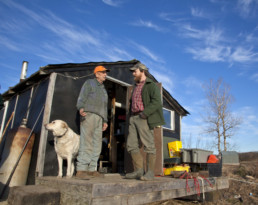
Sewell Look, left, and Dwayne Shaw
Photo: Leslie Bowman
Sewell’s stories were glimpses at the history, the culture of the river, the interaction of the people and the waterway, good and bad, and Dwayne listened. He cared. Cared about the fish and the river and the people along the river.
In 2004, other regions on the eastern seaboard realized population declines or even river-wide extinctions (mostly caused by the perpetuation of dams with inadequate fish passage), inciting the National Marine Fisheries Service to list the anadromous rainbow smelt as a species of concern, and the Maine Department of Marine Resources decided to shut down the commercial gillnet smelt fishery.
Few would have noticed the closure; it’s a small, isolated, quiet, fiscally worthless fishery. But Dwayne noticed. He cared about the fish and about the culture surrounding the fishery, and since scientific understanding of rainbow smelt and their habitat was lacking, he offered to work with the DMR to find out if—as he believed—the Pleasant River’s anadromous rainbow smelt fishery was indeed viable. In addition, DSF would work with DMR to develop a framework for ongoing management and conservation.
Although DSF would be the major facilitator of the smelt research, the small group already had its hands full and a budget strapped by its conservation projects. So Dwayne used mostly his own time—and that of volunteers like Bobby Beal—to collect the data. And that time came in late nights, eating gas station food, driving river to river along Downeast Maine’s unlit byways with a canoe and a truck bed full of smelt nets; headlamp scrambles down riprap river banks and bridge abutments when everyone else was home in bed; early mornings sampling fish, eating cold pizza, and drinking to-go coffee, logging data, evermore data.
He’d talk about catching smelts as a child, back when the train came through Columbia Falls, and they’d pack the fish end-for-end in wooden boxes…
From 2012 to 2018, Dwayne and DSF worked with DMR to survey 90 coastal rivers and streams in Washington and Hancock counties, and Dwayne canoed his gillnets into many of those waterways to learn first-hand what numbers of smelt were moving upstream, thus proving to the state that the Pleasant River was in fact an anomaly, that it could support the small-scale localized commercial fishing that it received.
The idea, if unspoken, was that the perpetuation of the culture that appeared to have no young recruitment was worth the hundreds of pounds of smelt that were landed each year—a drop in the bucket compared to the biomass the river supported.
Ironically, the local Pleasant River fishermen Dwayne was trying to help were his largest critics; not only was he trying to prove to the state that these guys weren’t hurting the river and the fishery, he was trying to prove to these guys that he wasn’t the one at fault for the regulations they were facing. To many of them, a scientist was a scientist, be he or she federal, state, or local.
The DSF, its small office building looming above their smelt shacks, represented science and regulation and change, a breach in the way things had always been done. No matter that Dwayne, with his thick beard and calloused hands and working-man’s frame, looked like any one of them; never mind that he’d sat night after night, year after year, in their smelt shacks, drinking beer and listening to stories; never mind that he’d accepted them, accepted their tales of poaching and misconduct; never mind that he was, literally, the only thing standing between the fishery they loved and the guillotine regulations that were headed their way.

In a “fake news” sort of manner, a scientist in charge of a conservation group standing up against regulations didn’t compute, didn’t add up, so every once in a while, when one or two of the more ornery fishermen drank too much, he’d lash out at Dwayne and the DSF.
Dwayne would smile, glance at Bobby and me, laugh his customary laugh, and with the same nonchalance he could incorporate when giving a presentation to a ritzy salmon fishing organization, he would say something like, “Yeah, us environmentalists, ruining all the fun, trying to keep you guys in business.”
That would be as far as it would go. Despite the orneriness, despite the bitterness that might well-up in the face of intangible change, the fishermen were small-town men who truly cared, and there was no arguing the fact that the Downeast Salmon Federation was a different breed of conservation group: it was a group of fishermen, back-to-the-landers, hunters, environmentalists, conservatives, liberals, rednecks, retirees—you name it—but what every one of them had in common was a love for Downeast Maine’s rivers, coasts, and communities.
Bobby and Dwayne and I sit in the truck several miles downstream from the pool and its attendant smelt shacks, watching the river, the heater blasting. We talk about the other rivers Dwayne has set nets in: the Narraguagus, the East Machias, the Dennys, and he’s found few, if any, smelt in any of them.
“Cuz it’s too damned cold,” Bobby says with a laugh.
High water comes and goes. Out there in front of us, the gillnet buoys dance between the wind and current. I gaze at the old Addison clam shucking house on the far bank, a glimpse at a time gone by, a time when resources were inexhaustible, when humankind was too small to harm the planet. Now, in that truck, I wonder if humankind is capable of helping the planet, fixing the damage caused.
We sit for perhaps another half hour, then slide the canoe
down through the mud and into the water. Slowly, carefully, we haul one net at a time, Dwayne standing in the bow of the canoe, flaking its icy lengths into a fish tray. The wind howls, presses against the canoe. Now and then, Dwayne tosses a stick aside, but he finds no fish. Not a single one out of 150 feet of net.
We load the truck, look out at the clapper dam that blocks the saltwater from rising any further up what was once a healthy tidal river. “The old folks,” Dwayne will later tell me, “remember smelt nets all the way up the West Branch, back before the clapper dam.”
That was all a few years ago now. The old poaching smelt kingpin, Sewell, has died; Louis, the fisherman with throat cancer, has died. The men who fished with them have taken over their licenses, their smelt shacks, and so each spring, the wood stoves still pump smoke through the nights, and the men still drag their skiffs down the gravel bank in order to set their nets in the darkness as the falls fill the night air with their sound, the old clock tower still aglow above it all, glimmering in the pool.
Not much has changed. The DSF took over the lease on a derelict smelt camp, and built its own camp, which serves as both a working smelt shack and an interpretive center for students, tourists, and community members.
Time blurs. The interpretive smelt shack is set in the row of functioning smelt shacks, and although Dwayne’s research did what he’d hoped it would do—he proved that the Pleasant River could support the East Coast’s only commercial gillnet smelt fishery, thus keeping it open—the end seems to be nigh. Whether it’s because the fishermen are aging, or that the smelt shacks are falling into insurmountable disrepair, or that the state will inevitably end the fishery, nobody truly knows.
But for now, what exists in Columbia Falls, and what DSF has helped create, is a merging of past and present in order to, hopefully, benefit the future of the river that binds people and place together. Late at night, men go out in skiffs and fish the antiquated fishery, and while they sleep the following day, local students gather only yards away to learn how it was once done.


